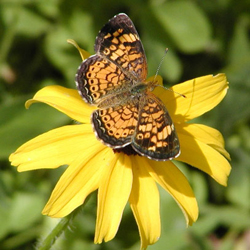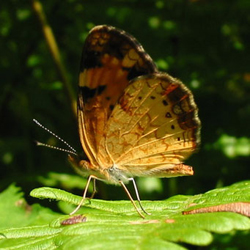Butterfly Atlas
Find a Butterfly
Pearl Crescent
Phyciodes tharos
Named
Drury, 1773

Taxonomy & Nomenclature
The names and taxonomic relationships of the northeastern crescents (Phyciodes) have been much "revised", leaving a certain amount of confusion in the literature. The name morpheus has been used for what was once thought to be the "hot weather form" of tharos and also as a species name synonymous in part with selenis (see Northern Pearl Crescent). Other subspecies and forms that have been attributed to tharos are now largely referred to selenis.
Identification
Wingspan: 1 - 1 1/2". Our commonest small orange and black butterfly, superficially similar to Silver-bordered Fritillary and Harris‘ Checkerspot. Male and summer female Pearl Crescents can be distinguished by the uniform golden ground color of the hindwing below etched with a tracery of darker veins but lacking the distinct variegated spotting that is characteristic of the fritillary and checkerspot. Dark spring female crescents are much blotchier, however the pattern is much less well defined by black lines than in either the fritillary or the checkerspot, looking rather smudgy by comparison. The manner of flight and "jizz" of each of these butterflies may also be helpful in distinguishing representatives of the three genera in the field. Klots (1951) notes as characteristic "the way in which, on alighting, (the Pearl Crescent) holds its wings out at the sides and saws them up and down a few times". Silvery Checkerspot and Northern and Tawny Crescents, all rare at best in our region, are also easily confused; their field marks are given in their respective species accounts.
Distribution
Southeastern Alberta and the eastern slope of the Rockies to southern Mexico eastward to southern Maine and throughout the Midwest and South. In New England, Pearl Crescent ranges from southeastern Maine and southern New Hampshire and Vermont southward throughout the other states. It is replaced at its northern limit by its sibling the Northern Crescent.
Status in Massachusetts
Abundant throughout the Commonwealth; perhaps even more so in the last century when the state had much more open habitat. Scudder (1889) says: "In New England it is almost everywhere exceedingly abundant". Maximum: c. 1000 in a large area of dry and wet meadows with many flowers 9 August 1989 at Barnstable airport (Barnstable Co.).

Flight Period in Massachusetts
Flies continuously from mid May to early September. This represents two broods: mainly late May through June and late July to mid-August, though they overlap in July. Extreme Dates: 14 May 1986, Millis (Norfolk Co.), B. Cassie; 16 May 1987, Bernardston (Franklin Co.), M. Fairbrother; 10 October 1988, Petersham (Worcester Co.), M. Fairbrother; 15 October 1994, Holliston (Middlesex Co.), R. Hildreth.
Larval Food Plants
Asters. The New England species it is known to feed on are Heath Aster (Aster pilosus), Many-flowered Aster (A. ericoides), Bushy Aster (A. dumosus), Calico Aster (A. lateriflorus), Whorled Aster (A. acuminatus), Smooth Aster (A. laevis), Panicled Aster (A. simplex), Purple-stemmed Aster (A. puniceus), and New England Aster (A. novae angliae). Commonly "drinks" at wet spots on the ground, sometimes gathering in numbers.
Adult Food sources
Because of its long season, the Pearl Crescent has been recorded as nectaring on many flowers species from a wide range of families. Atlas workers recorded it on 54 species of wild flowers.

Habitat
Like its food plants, the Pearl Crescent prefers open sunny habitats: fields, pastures, meadows, roadsides and weed lots.
Life Cycle
EGG: Pale yellowish green and glistening; a high dome with an open top and 18-25 vertical ribs, indistinct lateral lines between giving a wrinkled effect. OVIPOSITION: Females lay a total of c.700 eggs in clusters of 20-300 (av. 50-70) on the underside of aster leaves; these hatch in 4-10 days. LARVA: Boldly marked with chocolate brown, black and white and covered with bristly spines; the caterpillars feed together, unprotected by a web, moving gradually down the food plant; larval stage lasts about two weeks CHRYSALIS: Grayish white to yellow-brown; "minutely corrugated" with many bumps on the upper surface PUPATION: The chrysalis is suspended head downward by a silken holdfast (cremaster) - away from the host plant according to Scudder, (1889); pupation takes 6-30 days (usually about two weeks). OVERWINTERING STAGE: Third instar larva.
Courtship involves a chase and wing fluttering rituals followed by copulation.
Account Author
Chris Leahy



